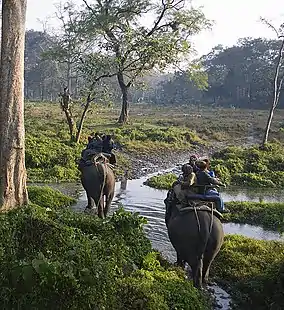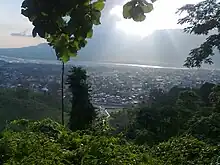Alipurduar district
Alipurduar District is the 20th district in the state of West Bengal, India.[2] The district has its headquarters at Alipurduar. It was made a district by bifurcating Jalpaiguri district in 2014.[3]
Alipurduar | |
|---|---|
  .jpg.webp)   Clockwise from top-left: Evening at Jaldapara National Park, ruins of Buxa Fort, Hut used by Toto aboriginals, Jayanti Hills in Buxa Tiger Reserve, Bhutan gate near Jaigaon | |
.svg.png.webp) Location of Alipurduar in West Bengal | |
| Country | |
| State | |
| Division | Jalpaiguri |
| Headquarters | Alipurduar |
| Government | |
| • Lok Sabha constituencies | Alipurduar |
| • Vidhan Sabha constituencies | Alipurduars, Kumargram, Falakata, Madarihat, Kalchini |
| Area | |
| • Total | 3,136 km2 (1,211 sq mi) |
| Population | |
| • Total | 1,491,250 |
| • Density | 480/km2 (1,200/sq mi) |
| • Urban | 307,456 |
| Time zone | UTC+05:30 (IST) |
| Website | alipurduar |
It consists of Alipurduar municipality, Falakata municipality and six community development blocks: Madarihat–Birpara, Alipurduar–I, Alipurduar–II, Falakata, Kalchini and Kumargram. The six blocks contain 66 gram panchayats and nine census towns.
Administration
Apart from the Alipurduar municipality and Falakata municipality, the district contains eight census towns and rural areas of 66 gram panchayats under six community development blocks: Madarihat-Birpara, Alipurduar-I, Alipurduar–II, Kalchini, Falakata and Kumargram.[4] Geographically the district lies in between 26.4°N to 26.83°N and 89°E to 89.9°E.
The nine census towns are Paschim Jitpur, Chechakhata, Alipurduar Railway Junction, Bholar Dabri, Sobhaganj, Jaygaon and Uttar Latabari and Uttar Kamakhyaguri.[5]
Railway network
Alipurduar railway division has at least 710 km of railway track. It is the largest division of the NFR zone. In Alipurduar district there are two major stations, Alipurduar junction(APDJ) and New Alipurduar (NOQ). There are other stations in the district viz. Falakata Railway Station, Kamakhyaguri Railway Station, Dalgaon Railway Station, Hasimara Railway Station, Rajabhatkhawa, Hamiltongunj etc.
Legislative segments
There are 5 assembly constituency in Alipurduar district :
| S No. | Name | Lok Sabha constituency | MLA | Party | |
|---|---|---|---|---|---|
| 10 | Kumargram (ST) | Alipurduars | Manoj Kumar Oraon | Bharatiya Janata Party | |
| 11 | Kalchini (ST) | Bishal Lama | Bharatiya Janata Party | ||
| 12 | Alipurduars | Suman Kanjilal | Trinamool Congress | ||
| 13 | Falakata (SC) | Dipak Barman | Bharatiya Janata Party | ||
| 14 | Madarihat (ST) | Manoj Tigga | Bharatiya Janata Party | ||
As per order of the Delimitation Commission in respect of the delimitation of constituencies in the West Bengal, the area under Kumargram block and seven gram panchayats under Alipurduar–II block, viz. Bhatibari, Kohinoor, Parokata, Mahakalguri, Shamuktala, Turturi and Tatpara–I constitutes the Kumargram assembly constituency of West Bengal. The Majherdabri gram panchayat under Alipurduar–II block and the area under Kalchini block constitutes the Kalchini assembly constituency. The Alipurduar municipality, the Alipurduar Railway Junction census town, and the gram panchayats of Chaporer Par–I, Chaporer Par–II and Tatpara–II under Alipurduar–II block and ten gram panchayats of Alipurduar–I block, viz. Banchukamari, Parorpar, Shalkumar–I, Vivekananda–I, Chakowakheti, Patlakhawa, Shalkumar–II, Vivekananda–II, Mathura and Tapsikhata form the Alipurduars assembly constituency. The other gram panchayat of Alipurduar–I block, viz. Purba Kanthalbari forms the Falakata assembly constituency along with the area under Falakata block. Madarihat block is part of Madarihat assembly constituency. Kumargram, Kalchini and Madarihat constituencies is reserved for Scheduled tribes (ST) candidates. Falakata constituency is reserved for Scheduled castes (SC) candidates. All these five assembly constituencies are part of Alipurduars (Lok Sabha constituency), which is reserved for ST candidates.[6]
Demographics
As of the 2011 census, Alipurduar district has a population of 1,491,250, of which 1,183,704 are rural and 307,456 are urban. Scheduled Castes and Scheduled Tribes make up 456,706 (30.62%) and 382,112 (25.62%) of the population respectively.[1]
Religion
| Religion | Population (1941)[8]: 90–91 | Percentage (1941) | Population (2011)[7] | Percentage (2011) |
|---|---|---|---|---|
| Hinduism |
144,898 | 45.17% | 1,194,102 | 80.07% |
| Tribal religion |
141,716 | 44.17% | 14,866 | 1.00% |
| Islam |
29,856 | 9.31% | 130,339 | 8.74% |
| Christianity |
1,385 | 0.43% | 112,091 | 7.52% |
| Buddhism |
--- | --- | 35,318 | 2.37% |
| Others[lower-alpha 1] | 2,963 | 0.93 | 4,534 | 0.31% |
| Total Population | 320,818 | 100% | 1,491,250 | 100% |
Hindus are the majority in all blocks. Muslims are spread evenly throughout the district, but Christians, traditional religions and Buddhists are concentrated in the tea garden areas.
Visitor attractions


- Buxa Tiger Reserve, IUCN category II national park
- Jayanti Hills
- Buxa Fort, built by British Raj
- Jaldapara National Park
- Chilapata Forests
- Jaigaon, a small town of Alipurduar district and near the Bhutan border
- Rajabhatkhawa Museum at Rajabhatkhawa
- Rajabhatkhawa Forest
- Raimatang
- Jayanti
- Santalabari
- Rovers point
- Roopang valley
- Lepchakha
- Chunabhati
- Chipra Forest
- Chilapata Forest
- Buxa Tiger Reserve
- Dima Bridge
- Vistadome Ride
- Tons of Tea Estates
Notes
- Including Jainism, Buddhism, Zoroastrianism, Judaism, Ad-Dharmis, or not stated.
References
- "District Census Handbook-Jalpaiguri" (PDF). Directorate of Census Operations, West Bengal. Retrieved 10 July 2021.
- TNN (21 June 2014). "Roy Alipurduar: Alipurduar a new district on June 25". Timesofindia.indiatimes.com. Retrieved 6 April 2020.
- IANS (25 June 2014). "Alipurduar becomes Bengal's 20th district | Business Standard News". Business Standard. Retrieved 6 April 2020.
- "Directory of District, Sub division, Panchayat Samiti/ Block and Gram Panchayats in West Bengal, March 2008". West Bengal. National Informatics Centre, India. 19 March 2008. Archived from the original on 25 February 2009. Retrieved 21 December 2008.
- "District Wise List of Statutory Towns (Municipal Corporation, Municipality,Notified Area and Cantonment Board), Census Towns and Outgrowths, West Bengal, 2001". Census of India, Directorate of Census Operations, West Bengal. Archived from the original on 21 July 2011. Retrieved 21 December 2008.
- "Press Note, Delimitation Commission" (PDF). Assembly Constituencies in West Bengal. Delimitation Commission. pp. 4–5, 23. Retrieved 10 January 2009.
- "Table C-01 Population by Religion: West Bengal". censusindia.gov.in. Registrar General and Census Commissioner of India. 2011.
- "Census of India, 1941 Volume VI Bengal Province" (PDF). Retrieved 13 August 2022.
- "Table C-16 Population by Mother Tongue: West Bengal". www.censusindia.gov.in. Registrar General and Census Commissioner of India.
- Basu, Moushumi (31 May 2018). "A rhino poaching racket has created fear, suspicion towards outsiders in a West Bengal village". scroll.in. Retrieved 29 July 2023.
- "Buxa Tiger Reserve Forests". indyatour.com. Indyatour. Retrieved 29 July 2023.